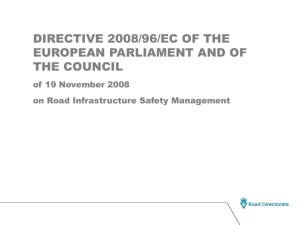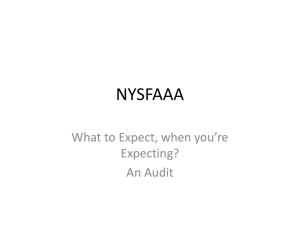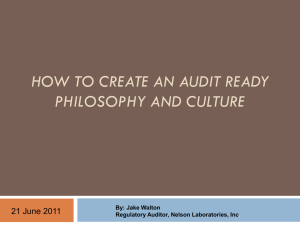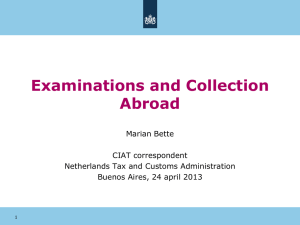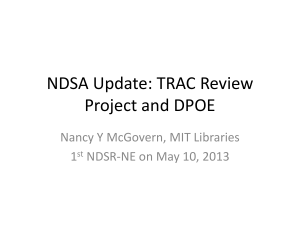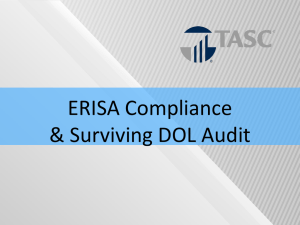PPT - EisnerAmper
advertisement
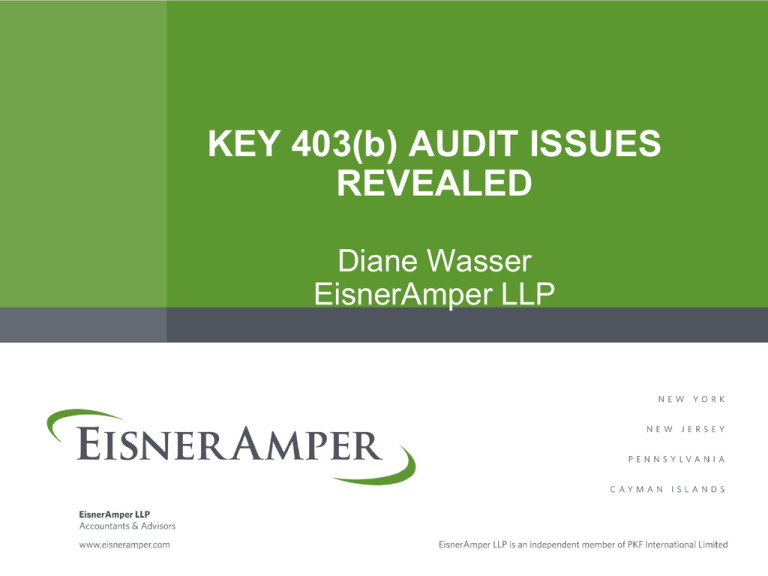
KEY 403(b) AUDIT ISSUES REVEALED Diane Wasser EisnerAmper LLP OVERVIEW 2009 was the first year audits were required for ERISA 403(b) plans… 2010 was a better year! Plan sponsors are still scrambling to gather appropriate information, in some cases Plan sponsors paying more attention to plan documents Organizations are faced with need for formal governance Many plan sponsors had difficulty obtaining information to support participant accounts for years prior to 2008, that will haunt them for many years Auditors continue getting acclimated to 403(b) specific plan provisions and designing 403(b) specific testing approaches 2 Large 403(b) Plans Initial Form 5500 Filings Per the Department of Labor • A number were filed without financial data − No Schedule I OR Schedule H Attached − Filed as in prior years – except through EFAST2 • A number filed without audited financial statements attached • Of audited financial statements received approx. 80% did not contain any disclaimer beyond the limited scope disclaimer on investments (29 CFR 2520.103-8) 3 Defining "The Plan" ERISA vs. Non-ERISA • Governmental plans (ERISA section 3(32) ) • Church plans (ERISA section 3(33)) • "Safe Harbor" Plans − DOL regulation 29 C.F.R. § 2510.3-2(f) "Improper" plan documents Safe Harbor plans with "ERISA" documents Safe Harbor plans that filed 5500s ERISA plans that never filed 5500s 4 What We've Seen – Defining "The Plan" How many plans are there? • Multiple plans vs. multiple vendors • "Old" Plan vs. "New" Plan • 403(b) "Safe Harbor Plan" plus 401(a) Plan • 401(a) with Profit Sharing formula (Discretionary) • 401(a) with a Money Purchase Plan formula (Fixed %) • 401(a) with a Matching formula (Based on the 403(b) Plan) Plan Provisions Optional Plan provisions: • Loans • Hardship withdrawals • Plan-to-plan transfers, contract exchanges • Acceptance of rollovers 6 Plan to Plan Transfers Cannot transfer 403(b) plan assets to non-403(b) plans. If an employer decides to freeze or terminate a 403(b) plan, cannot merge the 403(b) plan assets into a 401(k) or 457(b) plan. The Rollover Exception: Via the rollover process, plan participants receiving a distribution can transfer money to a 401(k), 457(b) or IRA. 7 Plan Termination Prior rules did not allow for plan terminations. An employer's only option was to freeze the plan, stop contributions. New regulations allow 403(b) plans to be terminated provided: • All plan benefits are distributed to participants as soon as practicable after termination, and • The employer does not contribute to another 403(b) plan for 12 months – similar to 401(k) plan Participants have the right to roll over such distributions to another eligible retirement plan; i.e., a 403(b), 401(k), 457(b) governmental plan, or IRA. 100% vesting required at plan termination: • Not applicable to non-ERISA plans 8 Universal Availability Granted to one then granted to all. Allowable exclusions: • Nonresident aliens • Students under a work study program (usually in post-secondary education institution) • Employees eligible to make deferrals to another 403(b), 401(k) or 457(b) plan • Employees who normally work less than 20 hours per week $200 annual minimum contribution requirement allowed (cannot impose a minimum percentage). Cannot impose a minimum age or service requirement in order to make deferrals. 9 Unusual Plan Attributes 15 year additional contribution • 15 years must be Years of Service with current employer: − $15,000 lifetime cap, never indexed − Do not have to offer in plan Plan loans Distribution options Multiple contracts Different terms and restrictions on investments Merger or no merger 10 Popular Compliance Issues Generally all stems from not understanding/referring to plan provisions Late Deposit of Participant Deferrals & Loan Repayments Failure to Properly Apply Plan's Definition of Compensation Failure to Follow Eligibility Provisions • Universal Availability vs. Employer contribution eligibility Failure to Properly Apply Plan's Vesting Provisions Improper of No Use of Plan Forfeitures No non-discrimination testing performed • Elective deferrals to 403(b) plans remain free from ADP testing (subject to universal availability). 11 Audit Opinions Modified opinions • FAB excluded contracts • Inability to obtain sufficient documentation for prior year balances and activity Certifications and language regarding trustee/custodian 12 Internal Controls SAS 115 Communications – Does a Disclaimer result in a Material Weakness? • "How can we disclaim an opinion and NOT have a Material Weakness?" • "Generally, a Material Weakness includes an expectation of correction. How can the client ever correct the past?" • "Won't the Material Weakness continue to be included in the 115 communications for as long as we disclaim an opinion?" 13 Successor Auditor Concerns Plan sponsor may wish to engage another audit firm • The new audit firm may not agree with the prior auditor's report? − Prior auditor issued 'clean' report − Prior auditor issued a modified report How will restatements be handled? 14 Positive Outcomes Longevity of employees involved in Plan management Deferral Forms on file at the Organization Payroll records on file at the Organization Knowledge of payroll slot vendors/records Knowledgeable consultants getting involved Responsiveness of Organizations to improving Plan governance Willingness of Organizations to engage ERISA counsel Willingness of Organizations to engage consultants 15 ASPPA Letter to DOL ASPPA and NTSAA recommend: that a committee of industry experts be established to suggest, review and modify the existing audit guidelines for 403(b) plans. The committee should specifically consider: • • • • The differences between group annuities, individual contracts, and individual custodial agreements and the potential for different audit requirements for each; The need for relief and clarification that beginning balances as of January 1, 2009, are absolute for all purposes under applicable auditing standards, and that auditors may modify their standard procedures and accept data provided as of January 1, 2010; Creation of a model "Audit Checklist" for 403(b) plans that is specific to 403(b)s and does not contain qualified plan requirements; and Better coordination between the Department's rules and the Internal Revenue Service compliance rules by creating educational communications and training materials specifically focusing on 403(b) plans for employers, vendors, auditors and administrators. 16 AICPA Recommendations (7/11) to ERISA Advisory Council The Department should continue to have formal dialogue with the 403(b) plan sponsor, vendor and audit communities on the continued application of the audit and reporting requirements. The Department should evaluate other alternative regulatory reporting approaches for those plans that may never be able to prepare full plan financial statements on accordance with generally accepted accounting principles. The Department should revisit the Plan Asset Rules in CFR 29 CFR 2510.3-101 to consider whether certain contracts and accounts (for example, 90-24 transfers; pre- January 1, 2009 contracts and accounts) can be excluded from plan assets and thereby provide additional reporting and audit relief. The Department should issue guidance on the appropriateness of loans to participants made outside the plan in which plan assets (i.e.- participant account balances) are used as collateral. The ERISA Advisory Council is expected to prepare a report of its recommendations to the Secretary of Labor sometime soon. 17 Plan Governance Best Practices Critical to employ fiduciary best practices, historically somewhat lacking in the 403(b) plan area Plan Committees • Meet regularly • Keep written minutes • Document fiduciary due diligence Investment Policy Statements ERISA attorney relationships Monitor service providers and fees Employ effective internal controls 18 Common Audit Deficiencies Common audit deficiencies found in EBP audits by the DOL and the AICPA Peer Review Program fall into the following categories: • Participant Data • Investments • Contributions • Benefit Payments • Related Party/Prohibited Transactions • Other 19 Plan Audit Universe 200+ audits 39 Firms/5,300 audits 100-199 EBP audits 50-99 EBP Audits 10,000+ Firms/ 40,000+ audits 29 Firms/22,400 audits 115 Firms/7,735 audits 25-49 EBP audits 24 or less EBP audits 20 Looking Forward - DOL Continue to monitor compliance Continue to discuss issues going forward DOL 403(b) Website: http://www.dol.gov/ebsa/403b.html 21 Looking Forward – Auditors AICPA Joint 403(b) Audit Task Force • Work with DOL to monitor compliance • Work with DOL and others to develop and recommend alternative reporting compliance • Continue outreach with additional tools and presentations 22 Discuss: What Issues Concern You? What is your biggest concern for audits going forward? What is your client's biggest concern? What is the most important thing you learned from audits that you would change in the next audit, and how? How will you be communicating differently with your clients? Service providers? How will you plan to conduct your audits more efficiently? What can your clients do to make the audit process more effective? More efficient? 23 RESOURCES & SUPPORT 403(b) Plans Resource Center on EBPAQC website at www.aicpa.org/EBPAQC DOL page at www.dol.gov/ebsa/403b.html Current Tools: − 403(b) Primer; Analysis of reporting and audit requirements − "Getting Started" tool; Sample PBC List; Sample Questions to Expect From Your Auditors − 403(b) Retirement Plan Audits - Frequently Asked Questions (FAQs) − 2011 EBP Audit Risk Alert24 − 8-hour self study course "Audits of 403(b) Plans: A Challenging New Audit Area" – available at cpa2biz.com 24 The material contained in this presentation is for general information and should not be acted upon without prior professional consultation. The speakers' insights are their own and are not the opinions or positions of the AICPA or PKF North America. 25 Diane Wasser, CPA, Partner-in-Charge Pension Services Group EisnerAmper LLP 908.218.5002 x 2253 diane.wasser@eisneramper.com Diane has more than 20 years of experience providing employee benefit plan audit and consulting services to publicly and privately owned entities across the United States. Diane serves on the AICPA's Employee Benefit Plan Expert Panel, was previously appointed to serve on the Executive Committee of the AICPA's Employee Benefit Plan Audit Quality Center and serves on AICPA Task Forces, including the 403(b) Task Force. She also serves on the PKF North America Employee Benefit Plans Committee. Diane is instrumental in assisting the profession in applying generally accepted auditing standards to benefit plans and in understanding the unique reporting and regulatory requirements. In addition, she has worked with the AICPA in the production of employee benefit plan auditing self-study courses. A frequent speaker and writer, Diane is a repeat instructor at AICPA's national conferences and conference calls on employee benefit plan audit topics. She presents at several State CPA societies' ERISA conferences as well as in front of plan sponsor audiences. In 2009, Diane was named one of New Jersey's Best 50 Women in Business by NJBIZ magazine. She is a member of the following organizations: • • • • • • • American Institute of Certified Public Accountants New Jersey Society of Certified Public Accountants New York State Society of Certified Public Accountants Pennsylvania Institute of Certified Public Accountants Connecticut Society of Certified Public Accountants International Foundation of Employee Benefit Plans American Society of Pension Professionals & Actuaries Diane received her B.S. from Miami University in Oxford, Ohio 26


